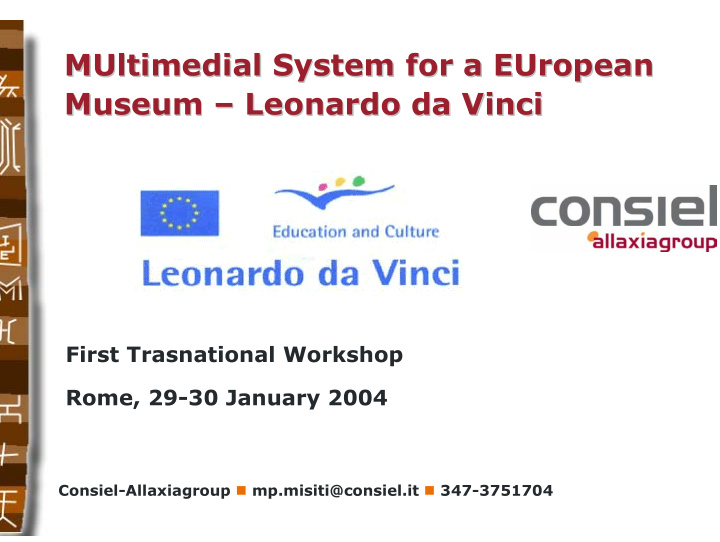



MUltimedial System System for for a a EUropean EUropean MUltimedial Museum – – Leonardo da Vinci Leonardo da Vinci Museum First Trasnational Workshop Rome, 29-30 January 2004 Consiel-Allaxiagroup � mp.misiti@consiel.it � 347-3751704
Content : : Content Objectives Expected Results Themes GdL Organization and Modes of Operations Project structure Partners Master plan Project Time line Products table 2 MU.S.EU.M. Project– Rome, 29-30 January 2004
Objectives : : Objectives Development of a formative model whose scope is the creation of new professional competencies aimed towards the planning and management of a mixture of art-culture-technology-economics: Finalizing the “MU.S.EU.M.” model; � Adaptation of the European training systems to the opportunities provided by � technology and data transmission; Overview of the potential human resources needs in the various professional � fields within the scope of the virtual museum; Collection of data on the identified professions; � Initiation of an ongoing training network in the Museums in the major � European capitals; Experimental laboratory for didactic support of FAD both on line and on the � job; The presentation of a Virtual museum as a competitive investment with � advantages over the museum-business culture; The transfer of the MU.S.EU.M. model over the entire productive system; � The opportunity for partnered museums to introduce and experiment with � accepted formative innovative and technological improvements. 3 MU.S.EU.M. Project– Rome, 29-30 January 2004
Expected results : : Expected results Identification of key professional figures for the development of the virtual museum The establishment various elements in training curricula with in the scope of the proposed virtual museum The defining of professional profiles and career paths for the various job positions taking part in the virtual museum project Creation of a Network of museums in the various European capitals, directed at the creation of a permanent learning environment aimed at improving the quality of the computerized cultural data offered 4 MU.S.EU.M. Project– Rome, 29-30 January 2004
Temes : : Temes The involvement some of the most important museum of Europe’s capitals in the development and construction of a prototype of a “ Virtual Museum presenting the European roots” centering on the theme of communication in prehistory The presentation of a series of prints, objects and architectural and urban planning contexts of great communicative impact The necessity of highlighting the importance of communication, the existence of storehouses of information and communicative channels able to convey complex messages even with in a “primitive” society 5 MU.S.EU.M. Project– Rome, 29-30 January 2004
GdL Organization and Organization and GdL Modes of operation : : Modes of operation Composition of the managing group : • Project Coordinator (Consiel) • Partners’ managers Project Coordination; The development of an annual program and quarterly verification of progress Individual teams ( senior e junior personnel ): Present in each country , in Italy directed by the Project coordinator and in the other countries by the people in charge of the corresponding partner: Intermediate and final research reports established by the program; detailed reports of activities and the relative financial accounts Operational management: Consiel The management of the organizational aspects as a whole and the relationship with the Leonardo coordination group and the commission; The writing of reports at a project level 6 MU.S.EU.M. Project– Rome, 29-30 January 2004
Project Structure : : Project Structure Phase 1: Executive planning Phase 2: the development of a conceptual frame of reference and action plans for each sector Phase 3: Structure and architecture of the MU.S.EU.M portal. Phase 4: requesting and analysis of offers, of its development scenarios, of the emerging professional roles, profiles and training needs Phase 5: Conception of a prototype of a cultural heritage distance training model (FAD) Phase 6: creation of local teams for the testing of the model Phase 7: European Laboratories for the testing of the model Phase 8: Further development of the formative model for MU.S.EU.M. for the professional and skillful management of museums Phase 9: diffusion of the formative model MU.S.EU.M. 7 MU.S.EU.M. Project– Rome, 29-30 January 2004
I partners partners: : I MUSEUM FOR SPERIMENTATION: � Budapest History Museum TECNICAL PARTNERS : � Consiel Allaxiagroup � Museo Nazionale Preistorico ed � Comital Srl Etnografico L.Pigorini � Eddleston Innovation Ltd � Museum für Vor- und Frühgeschichte of Berlin � Euro Innovanet Srl � Muzeul National de istorie a � UIL – Unione Italiana del Romaniei of Bucharest Lavoro � National Museum of History of � University of Alba Julia “1 Sofia Decembrie 1918” University – Pre- and Protohistorical � National Archaelogical Museum of Research Centre Athen � Naturhistorisches Museum- Prähistorische Abteilung of Vienna 8 MU.S.EU.M. Project– Rome, 29-30 January 2004
Master plan: Master plan: 9 MU.S.EU.M. Project– Rome, 29-30 January 2004
Time line : : Time line Diagramma di Gantt 10 MU.S.EU.M. Project– Rome, 29-30 January 2004
Products table table: : Products 11 MU.S.EU.M. Project– Rome, 29-30 January 2004
11 Progetto MU.S.EU.M. – Rome, 29-30 gennaio 2004 12 MU.S.EU.M. Project– Rome, 29-30 January 2004
Recommend
More recommend